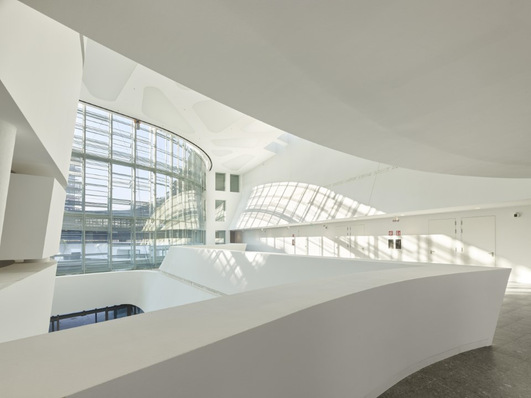Serial, modular construction, low-cost, recyclable facade materials, renewable energies and near-natural building greenery as well as seepage areas were the key to success here. One of Scandinavia's leading glass processors, Glaseksperten A/S, has contributed towards the realisation of the ambitious building concept of the BaseCamp Lyngby on several occasions: Automated production of the insulating glass units, varying direction-dependent glass construction and use of the warm edge spacer system Super Spacer T-Spacer Premium Plus.
Record-breakingly fast, sustainable and economical

Kontraframe
The running track on the roof of Google's new European headquarters in London will be used for the first time in 3 to 4 years at the earliest. The residents of BaseCamp Lyngby, built on a 41,000 square metre site, were able to don their running shoes as early as August 2020: a park landscape was created on the green roof of the extensive student residence complex in northern Copenhagen using a system of biodiverse planting, urban gardening areas and an 800-metre-long path that can be used for walking or jogging as you please. From the flat terrain, it winds its way up six storeys above the organically shaped building back down to the starting point while enclosing cosy inner courtyards and a circular community centre in the process. The facades are reminiscent of tall trees and forests by virtue of the vertical arrangement of the panels in three different shades of oak wood as well as the line of windows, and in just the same way as the entire complex they blend harmoniously within the surrounding nature. The project developer, BaseCamp Student Nordics, a part of the Europe-wide BaseCamp Group, deliberately wanted to give something back to Lyngby Municipality and enter into dialogue on social and environmental aspects. The roof is therefore open to the public to provide meeting areas.
The construction time for a project of this size is impressive. The 786 flats, including 639 student flats and 48 senior flats, were completed near Lyngby University of Technology within the space of two and a half years. The building was also intended to be no less spectacular, but one aspect distinguishes BaseCamp Lyngby from many other major projects: Ecology and economy determined the architectural concept equally.
Modules as the basis of architectural aesthetics

Kontraframe
In order to meet the estimated construction costs of around € 75 million the Danish firm of Lars Gitz Architects designed a trapezoidal module that is repeatedly rotated by 180° and stacked at different heights to create the gently rounded structure. The outer skin also constitutes a model example of cost-efficient construction. The ventilated curtain wall is insulated with rock wool and clad with slabs made of pressed volcanic basalt rock from Rockpanel. With a weight of 8.4 kg per m2, the extremely light material can be cut to size on site and simply attached to the substructure.
[Super Spacers help to make glass facades more sustainable]
The facades panels with their natural wood look almost entirely consist of natural volcanic rock and recycled rock wool and can be repeatedly reused in line with the idea of a circular economy. This makes the facade one of the pillars of the sustainability concept, which has been awarded BREEAM Very Good certificate (equivalent to the DGNB certificate in silver). The energy-saving green roof with the photovoltaic modules serves as a form of thermal insulation, an energy provider and natural air conditioning. The rainwater that is captured is returned to the natural water cycle via evaporation, which consequently relieves the burden on the sewage system and lowers the ambient temperature.

Kontraframe
Energy-efficient windows with warm edge spacers
The aluminium windows with triple glazing also form part of the overall concept. As is so often the case in Scandinavian architecture, the BaseCamp studios and communal areas are glazed down to floor level to allow as much daylight as possible into the room even during the winter. The Danish insulating glass manufacturer Glaseksperten supplied 4,000 insulating glass units packaged in sizes of up 4.011 x 1.127 metres to the construction site in accordance with a meticulous logistics plan. Due to the organic shape of the building, the glass structures change according to the direction. Depending on the heat input and amount of light, solar control glass, thermal insulation glass or clear glass with varying coatings and glass thicknesses were used. Glaseksperten opted for Super Spacer T-Spacer Premium Plus in various widths as the warm edge spacer system. Sales Manager Jesper Hønning declared: "An ever-increasing number of our customers wish to install energy-efficient windows. We consistently use low-emission thermal insulation glass and solar control glass combined with non-metal warm edge spacers in order to avoid thermal bridges and optimise the heat transfer coefficient.”

Kontraframe
[Calligraphic windows for the Museum of the Future]
At the company's headquarters in Hjørring, an ultramodern, automated IG line is available for the production of insulating glazing for sizes of up to 3.2 x 6 metres. "Super Spacer is of key importance to Glaseksperten in supplying quality products which also ensure we are a leading company in economical and ecological terms", Hønning went on to say, "the fully automated continuous application of spacer from the reel saves time and money and guarantees top class product quality that is reproducible.” Joachim Stoss, Managing Director of Edgetech Europe GmbH and Vice President International Sales at Quanex added: "Northern Europe is a global pioneer in the field of climate protection and therefore one of the growth markets for warm edge products. Of course, we are extremely proud that our Super Spacer system has been installed in another Scandinavian flagship project".













